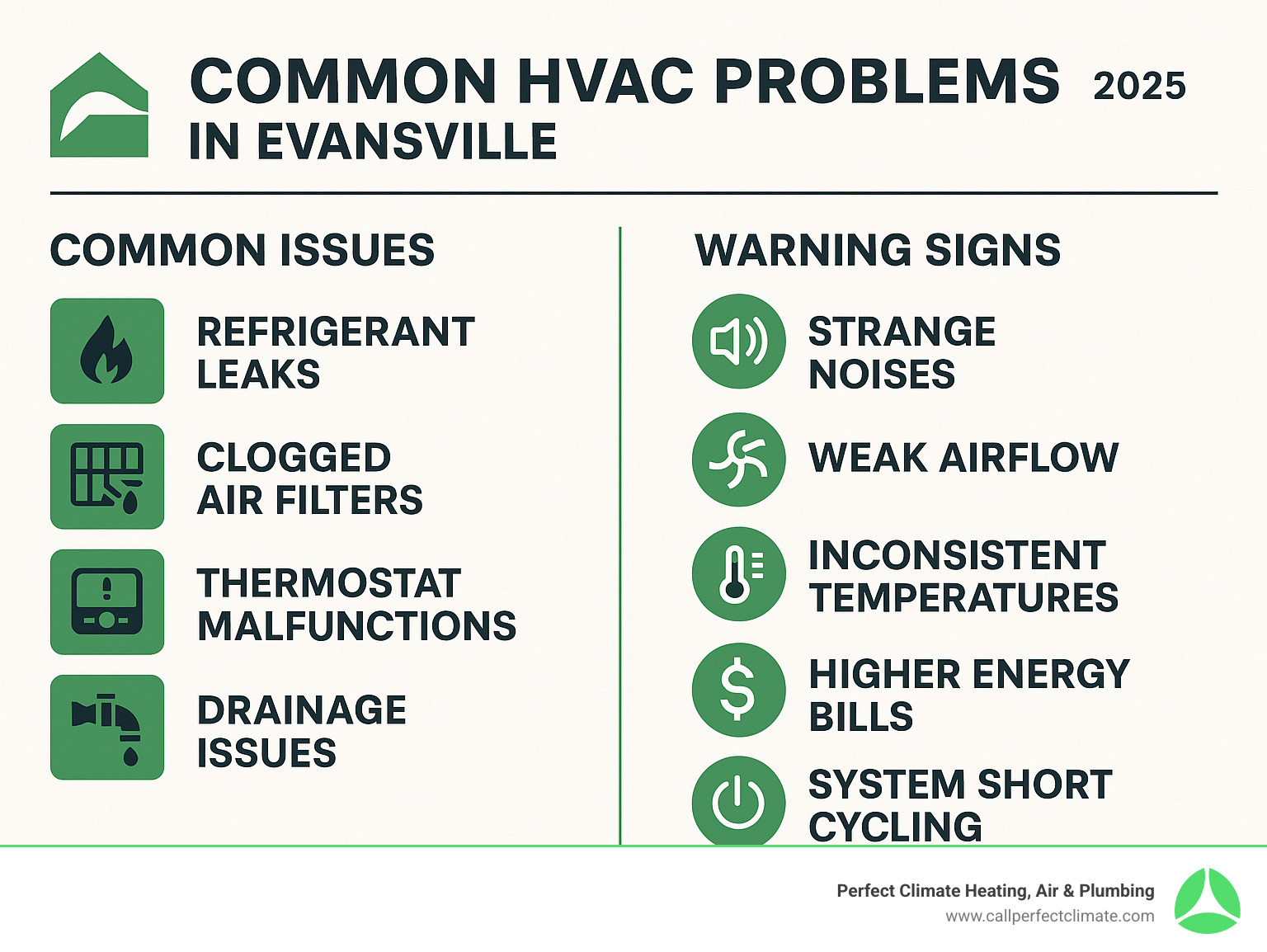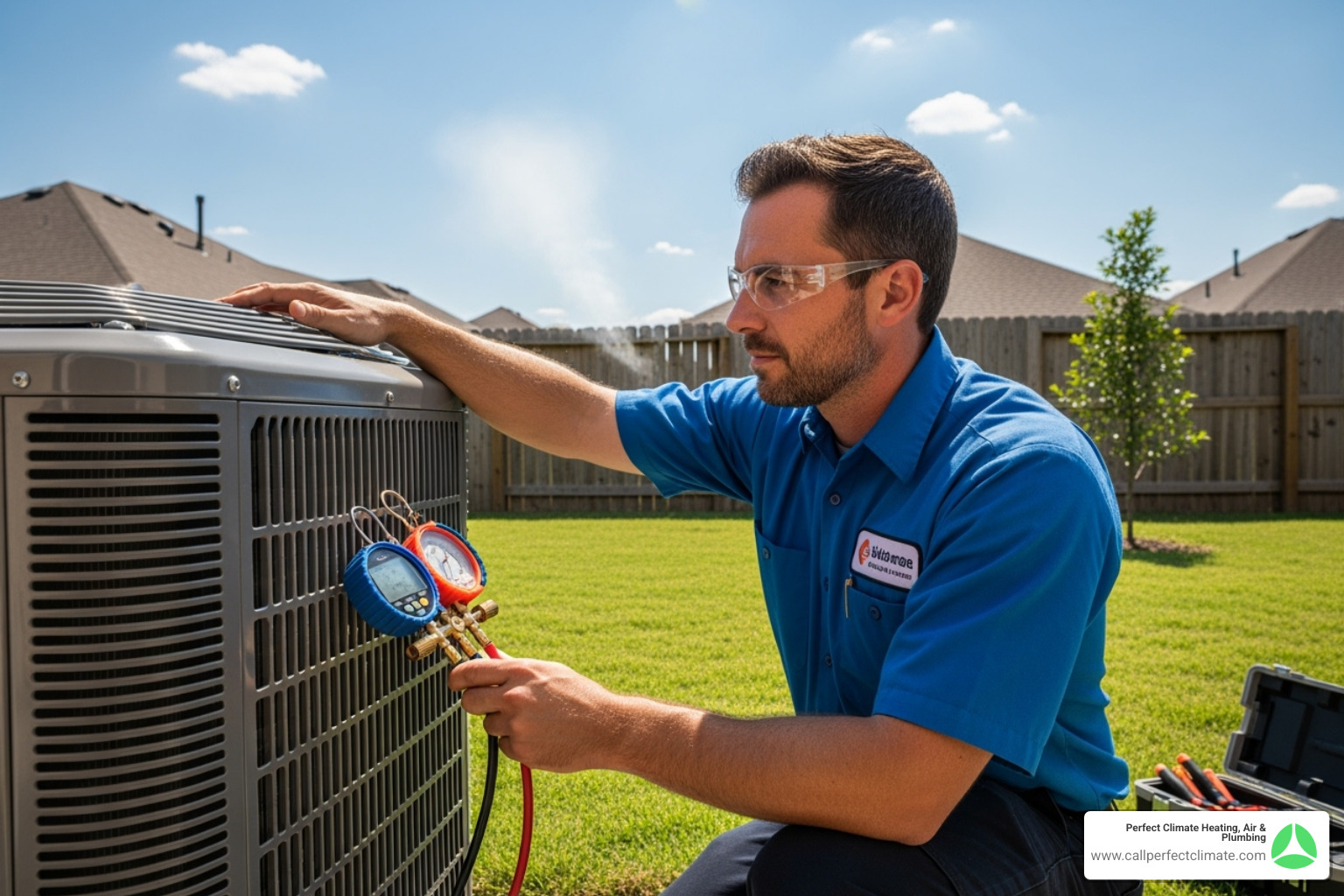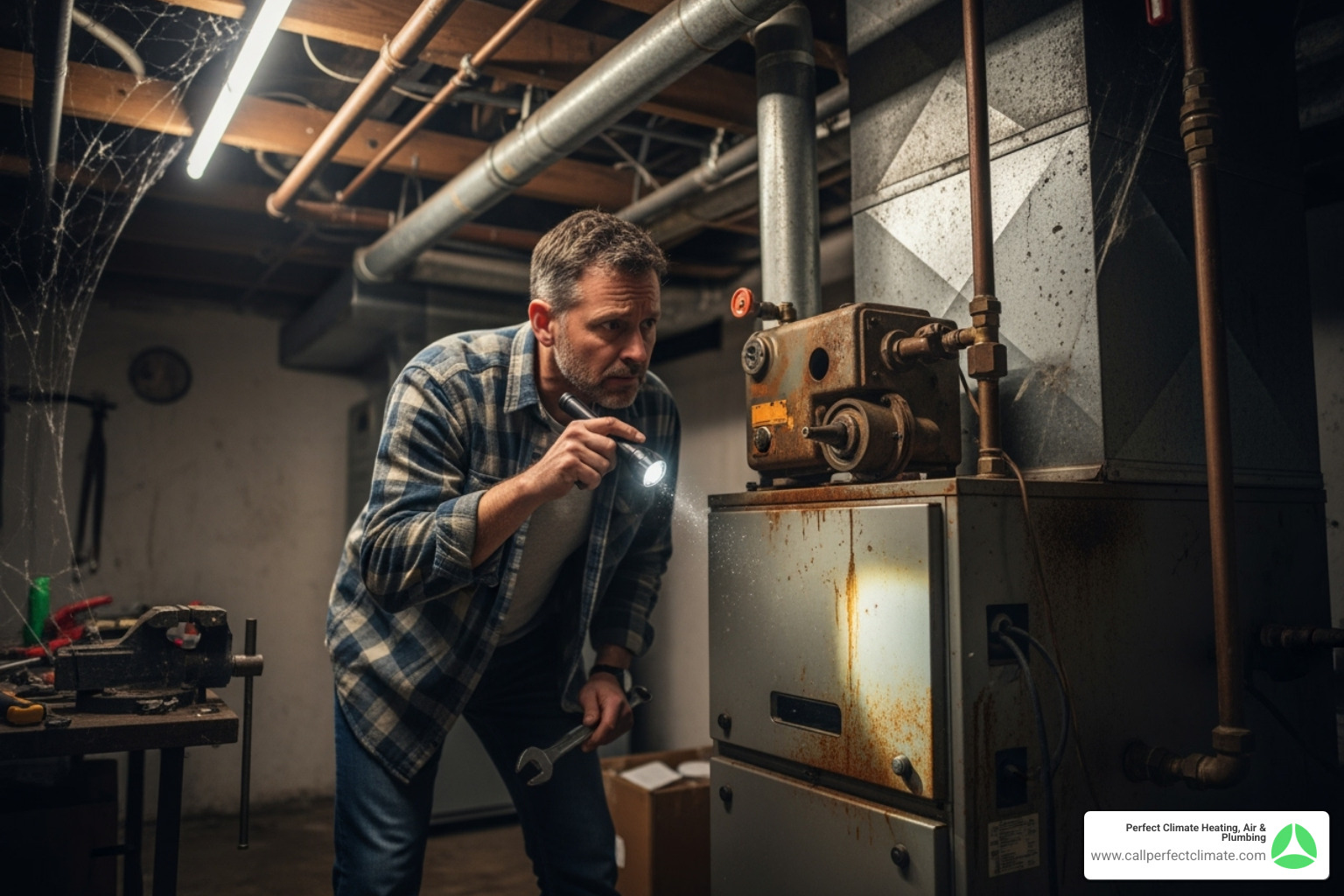Why Your Home’s Comfort Depends on Reliable HVAC Service
When you need HVAC repair Evansville IN, you’re likely dealing with a system that’s stopped working when you need it most. Whether it’s your air conditioner failing during a sweltering summer day or your furnace breaking down in the middle of winter, HVAC problems never happen at convenient times.
Quick Answer for HVAC Repair in Evansville:
- Emergency Service: Most local companies offer 24/7 emergency repairs
- Repair Costs: Minor issues range from $150-$400, major repairs $400-$1,000+
- Common Problems: Refrigerant leaks, clogged filters, thermostat issues, worn components
- When to Call: Strange noises, weak airflow, inconsistent temperatures, higher energy bills
- Top Local Companies: Several family-owned businesses with decades of experience serve the area
Evansville’s climate puts unique demands on HVAC systems. The hot, humid summers strain air conditioning units, while cold winters work heating systems hard. High humidity levels and seasonal pollen add extra stress to your equipment.
As one local customer shared after their heat pump lost power in negative temperatures: “The company was able to restore power and heat within a few hours.” This kind of prompt, reliable service makes all the difference when your family’s comfort is on the line.
Your HVAC system works around the clock to keep your home comfortable. When it breaks down, you need fast, professional help from technicians who understand both your equipment and Evansville’s challenging weather conditions.
Understanding Common HVAC Problems in Evansville’s Climate
Living in Evansville means your HVAC system faces some unique challenges. Between our sweltering summers and bitter winters, your heating and cooling equipment works harder than systems in milder climates. Understanding what can go wrong helps you spot problems early and avoid those middle-of-the-night emergency calls for HVAC repair Evansville IN services.
Refrigerant leaks top our list of common problems. Your air conditioner depends on refrigerant to move heat from inside your home to the outside. When there’s a leak, your system can’t cool properly, leaving you hot and frustrated while your energy bills climb. It’s like trying to fill a bucket with a hole in the bottom – not very effective.
Clogged filters might seem minor, but they cause major headaches. A dirty filter blocks airflow, forcing your system to strain like someone trying to breathe through a straw. This extra work can freeze your AC coils in summer or overheat your furnace in winter.
Your thermostat acts as your system’s brain, so when it malfunctions, chaos follows. Sometimes it’s as simple as dead batteries, but other times faulty wiring or sensors leave you with a system that won’t start or won’t stop running.
Furnace ignition problems become especially frustrating during our cold snaps. Whether it’s a failed igniter, pilot light issues, or gas supply problems, a furnace that won’t light means no heat when you need it most.
Over time, worn components like belts, motors, and capacitors simply give out from constant use. Think of them like the tires on your car – they’ll eventually need replacing. Finally, drainage issues plague many AC units when condensation can’t drain properly, leading to water backup, leaks, and system shutdowns.
Signs Your HVAC System is Failing
Your HVAC system usually gives you warning signs before it completely breaks down. Learning to recognize these signals can save you from emergency repair situations and help you plan for necessary HVAC repair Evansville IN services.
Strange noises are often the first red flag. A properly working system runs quietly, so banging, squealing, rattling, or grinding sounds mean something’s wrong. These noises typically point to loose parts, failing motors, or worn bearings that need attention.
Unusual odors tell their own story. Burning smells often indicate electrical problems or dirty motors, while musty odors usually mean mold is growing somewhere in your system. Trust your nose – if something smells off, it probably is.
When you notice weak airflow from your vents, or some rooms getting less air than others, your system is struggling. This could mean fan problems, ductwork issues, or severely clogged filters blocking the air’s path.
Inconsistent temperatures throughout your home create uncomfortable hot and cold spots. This uneven heating or cooling suggests your system can’t distribute air properly or is having trouble meeting your home’s demands.
Higher energy bills without increased usage often signal declining efficiency. When your system works harder to maintain the same comfort level, it uses more energy and costs you more money each month.
System short cycling – when your HVAC turns on and off frequently in short bursts – indicates serious problems. This stop-and-start pattern prevents your system from reaching proper operating temperatures and puts enormous strain on all components.
How Evansville’s Climate Impacts Your System
Evansville’s weather puts your HVAC system through a real workout year-round. Our climate’s unique combination of extreme temperatures and humidity levels directly affects how long your equipment lasts and how often it needs repairs.
Summer brings intense high humidity strain as your air conditioner works double duty. It’s not just cooling your air – it’s also pulling moisture out of it. This extra workload during our muggy months means more wear on components and higher chances of breakdowns when you need cooling most.
The summer heat stress keeps your AC running for hours on end during those scorching July and August days. Extended operation pushes your system to its limits and can reveal weak points in aging equipment.
Winter flips the script with heavy winter cold workload on your heating system. During those bitter cold snaps, your furnace or heat pump runs almost constantly to fight against the frigid outdoor temperatures. This continuous operation tests every component of your heating system.
Our area’s lush environment creates significant pollen and allergens that your HVAC system must filter from the air. While your system protects your indoor air quality, all those particles clog filters faster and can reduce airflow if not changed regularly.
All these climate factors combine to potentially reduce your system lifespan. While HVAC equipment typically lasts 15-20 years, Evansville’s demanding weather conditions can shorten that timeline without proper maintenance and care. That’s why choosing quality equipment and staying on top of regular maintenance becomes so important in our climate.
The Big Decision: Repairing vs. Replacing Your HVAC System
When your HVAC system starts acting up, you’re faced with a decision that can feel overwhelming: should you invest in repairs, or is it time to bite the bullet and replace the whole system? We understand this dilemma it’s one of the most common conversations we have with homeowners throughout Evansville, and there’s no one-size-fits-all answer.
The truth is, several key factors should guide your decision, and understanding them can save you both money and frustration in the long run. System age is perhaps the most telling indicator. Most HVAC systems have a lifespan of 15-20 years, and once your system crosses that threshold, you’re entering territory where replacement often makes more financial sense than continued repairs.
Repair frequency tells its own story. If you find yourself needing HVAC repair Evansville IN services multiple times per year, your system is essentially crying out for retirement. The cost of repairs becomes crucial here when repair bills start approaching significant portions of a replacement cost, you’re essentially throwing good money after bad.
Then there’s energy efficiency, measured by Seasonal energy efficiency ratio (SEER) for air conditioners and Annual fuel utilization efficiency (AFUE) for furnaces. Older systems, even when functioning, are energy guzzlers compared to today’s high-efficiency models. A system installed 15-20 years ago likely operates at much lower efficiency standards, meaning it’s costing you extra every month on your utility bills.
When to Consider Repair for your HVAC repair Evansville IN needs
Sometimes, repair is absolutely the right choice, and recognizing these situations can save you thousands of dollars in unnecessary replacement costs. The key is understanding when your system still has good years ahead of it.
Minor issues are almost always worth fixing. When you’re dealing with problems like a clogged drain line, a faulty thermostat, or a simple electrical connection issue, these repairs typically cost a fraction of replacement and can restore your system to full functionality. Think of these as the equivalent of changing your car’s oil necessary maintenance that keeps everything running smoothly.
If your system is under 15 years old, it’s generally in the prime of its life. Even if you encounter a moderately expensive repair, the remaining lifespan of your system usually justifies the investment. A well-maintained system in this age range should give you many more years of reliable service.
One-time breakdowns happen, even to the best systems. If your HVAC system has been a faithful servant for years and suddenly encounters its first major hiccup, don’t panic. This could simply be an isolated incident rather than the beginning of the end. Quality systems can bounce back from single component failures and continue operating reliably.
The economics matter too. When repairs are cost-effective fixes that restore full functionality without breaking your budget, they make perfect sense. We always provide honest assessments about whether a repair will truly solve your problem or just delay the inevitable.
Many homeowners follow the “50% rule” if the repair cost is less than 50% of what a replacement would cost, repair is typically the smarter financial choice. This guideline helps ensure you’re not over-investing in a system that’s nearing the end of its useful life.
When Replacement is the Smarter Choice
While we’re always happy to help with repairs, sometimes the most honest advice we can give is that replacement will serve you better in the long run. Recognizing these situations can save you from the frustration of repeated breakdowns and escalating repair costs.
Once your system is over 15 years old, you’re entering the zone where replacement becomes increasingly attractive. Even if the system is still functioning, older equipment faces higher breakdown risks and operates at lower efficiency standards. The peace of mind that comes with a new, warrantied system often outweighs the cost difference.
Frequent breakdowns are your system’s way of waving a white flag. If you’re calling for service every few months, those repair costs add up quickly. More importantly, you’re dealing with the inconvenience and discomfort of repeated system failures. A new system eliminates this cycle of problems.
Major component failures present a particularly clear-cut case for replacement. When critical parts like compressors or heat exchangers fail, repair costs can approach 70-80% of replacement cost. At that point, you’re essentially paying most of the price of a new system to get back an old one with other potentially failing components.
Modern homeowners increasingly prioritize energy efficiency, and rightfully so. If you have a desire for higher efficiency, replacement with a high-SEER air conditioner or high-AFUE furnace can dramatically reduce your monthly energy bills. These savings compound over time, often offsetting much of the replacement cost.
Finally, poor performance that persists despite repairs indicates a system that simply can’t meet your home’s needs anymore. Whether it’s inadequate cooling capacity, uneven heating, or inability to maintain consistent comfort, a properly sized new system can transform your home’s comfort level.
| Scenario | Frequent Repairs (Old System) | New Energy-Efficient Installation |
|---|---|---|
| Year 1 | $800 in emergency repairs + high energy bills | New system investment with warranty protection |
| Year 2 | $600 more in repairs + continued high energy costs | Lower energy bills (up to 30% savings) + reliable operation |
| Year 3 | $900 major component failure + ongoing efficiency loss | Continued savings + peace of mind |
| 5-Year Total | $2,300+ in repairs + thousands in excess energy costs | Significant energy savings + no repair costs under warranty |
This comparison shows how repair costs accumulate over time, while a new efficient system provides predictable operation and substantial energy savings that help offset the initial investment.



